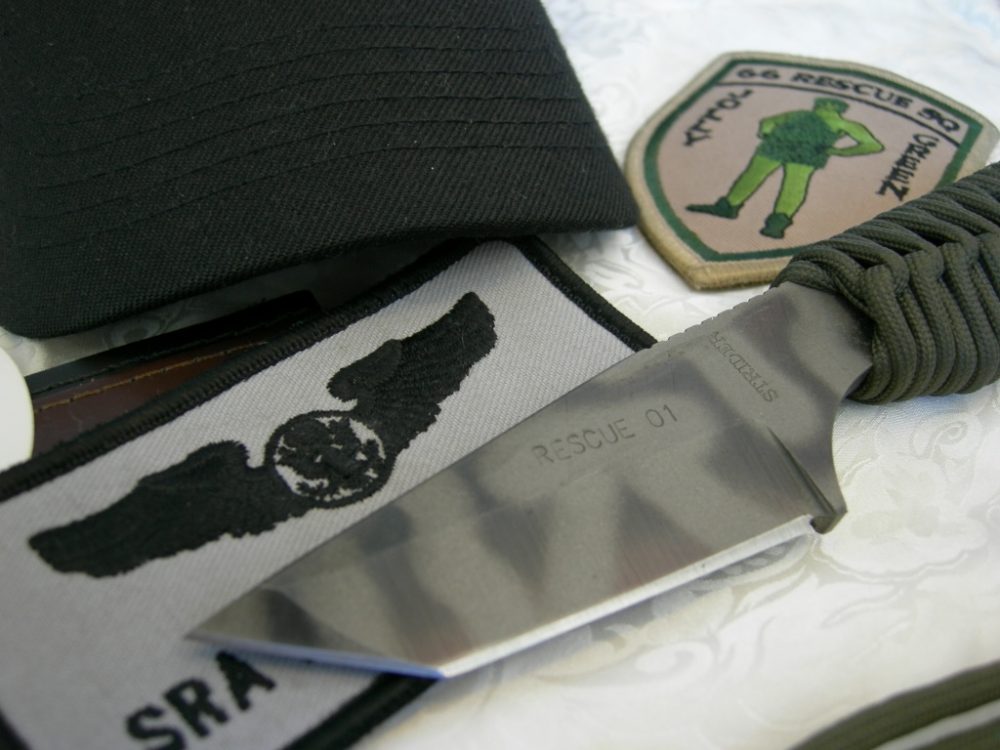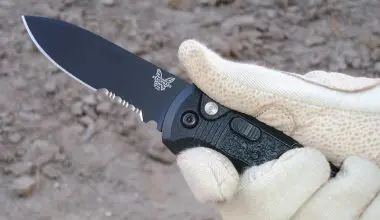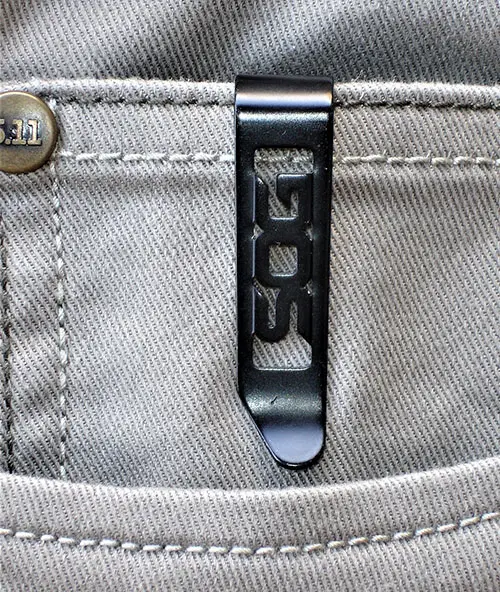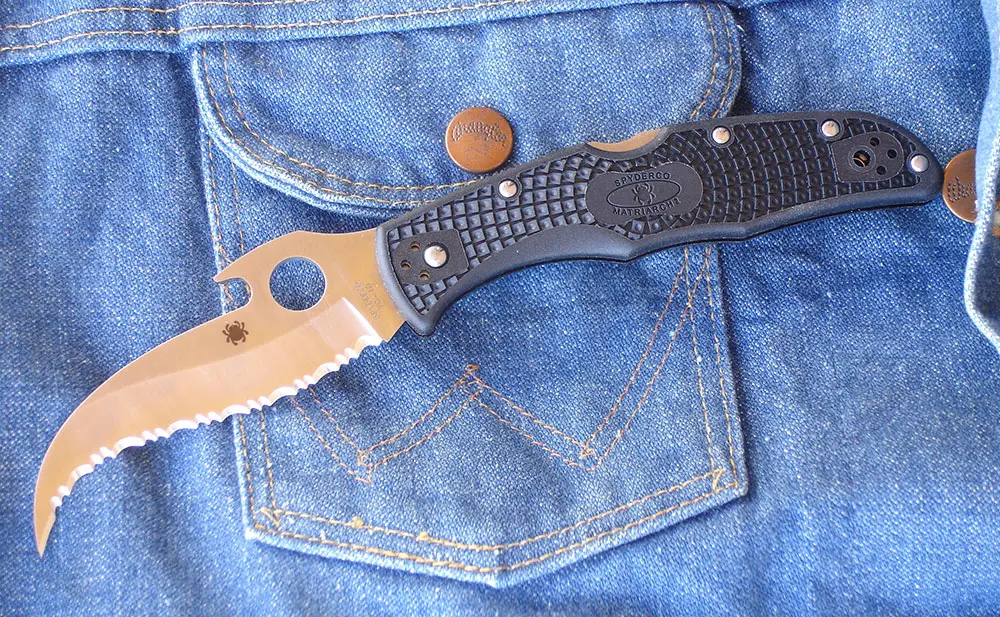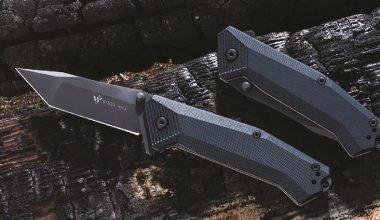 “EDC” stands for “everyday carry,” but the “everyday” part of the moniker refers to reliable enough for constant use, not “ordinary.” A blade you choose to always have with you may not be collector grade, but it will be one you are confident is always going to get the job done.
“EDC” stands for “everyday carry,” but the “everyday” part of the moniker refers to reliable enough for constant use, not “ordinary.” A blade you choose to always have with you may not be collector grade, but it will be one you are confident is always going to get the job done.
The past hundred years or so have seen a parade of genuinely serviceable “pocket” knives, from a “pen” knife, to a gentleman’s knife, to the ubiquitous jackknife, to the advent of more capable single-bladed folders. This Barlow-onsteroids genre caught on and Buck led the way with their classic Model 110 Folding Hunter. Bigger locking blades are now the normal carry blade.
They were such a great idea but so hard on pockets that makers soon sold them with a small belt pouch, and then with handy pocket clips of every creative description—all designed to ensure you’d have this universal and capable tool with you and handy when you needed it.
“Capable” is the operative word here, as these more robust blades are capable of more serious work than a jackknife. For most functions, a strong folder will do the same job as a small fixed blade and, depending on the venue, may be more socially acceptable. More recently, the one-handed-open option pioneered by Spyderco has become almost universal.
Auto openers are suspect in many benighted jurisdictions, and thumb studs, thumb holes, flippers and the newer assisted—but not automatic—opening devices ensure you have a ready tool even when the other hand is holding on to the work piece or otherwise engaged.
We did not find any industry numbers, but I’d hazard a guess that the robust single-bladed folder may now outsell the traditional multi-blade jackknife, especially when you figure in the additional sales lost—especially among gadget freaks—to multi-tools.
The popularity of these single-bladed “everyday” tools has led to innovation and competition, both of which work to the benefit of the consumer in a free-enterprise arena.
Within the genre itself, there is a wide variety of style, capability and price. We’ve rounded up what we feel represents a good cross-section, offering varying features to accommodate your needs and giving everyday good service at an everyday price. In alphabetical order, here are our picks:
Table of Contents
 BROWNING OBSESSION
BROWNING OBSESSION
You see some gun names on knives today, many just licensed names with no other association. Browning, however, offers a full line of cutlery for tactical or general use, and everything of theirs I have examined, from knives to tomahawks, was worthy of the name.
The Browning M713 Obsession™ is a trim liner-lock with three-inch drop-point blade of Sandvik 12C27 stainless. It has contoured stainless grip panels, G-10 inserts and a stainless pocket clip. Its smooth contours and finish make a good pocket carry without the clip. It opens smoothly with ambi thumb stud and closes one-handed by a jimped liner release. Showing good fit and finish, it’s intended for EDC. Aside from general cutting duties, its full belly radius and hollow grind would also make a good field-dressing folder. It has a lanyard hole and open architecture for easy cleaning after gutting steelhead or game.
 BUCK M110 FOLDING HUNTER
BUCK M110 FOLDING HUNTER
In 1962, advantages of small Bowies (non-collapsing, more capable blade) and the ubiquitous jackknife (handy constant carry, non-threatening) combined in Buck’s 110 Folding Hunter, and a new genre was born. I bought the first one I saw. Still in full-bore production by Buck, it’s changed little over the years. Buck now offers many models, even custom-shop versions—and most cutlers make a similar model, which users often call a “Buck Knife,” maker notwithstanding. Its 50-year history and essential class has created collector interest and organizations.
The Buck 110 will always be a fine tool. The 110 opens by conventional nail notch or adapts to thumb studs. The feature that makes it America’s most-carried folder and Buck’s signature knife is that its 3¾-inch blade locks up solid. The Buck 110 is American made of 420HC and has a clip point in a 4 7/8-inch, seven-ounce envelope. It also features brass bolsters, Dymondwood scales, and a leather sheath. Everybody needs one.
 CASE HUNTER LOCKBACK
CASE HUNTER LOCKBACK
A great American company that has been making folders for more than 100 years is Case. This utilitarian model of lockback design is the Case “Hammerhead” Hunter Lockback. It’s cataloged as “ground” finish, but comes polished even internally, with a really robust Zytel handle in businesslike Olive Drab. The stainless clip-point blade is 3½ inches, hollow ground and delivered razor sharp. It locks up precisely with no play in any direction and opens smoothly via an elongated thumb nick.
It weighs only 2.5 ounces and comes in a decent black nylon belt pouch, although since it’s a clean, no-nonsense blade with no extraneous appurtenances, we found it perfectly pocketable. Subdued positive checkering gives a good grip in slippery conditions, and it’s a comfortable grab bare-handed in cold weather. Case is not just your Daddy’s collectible jackknife—this is a workingman’s blade that’s really easy to have with you.
 COAST FX413
COAST FX413
Coast was supplying knives to loggers, fishermen and farmers of the Pacific Northwest when Kaiser Wilhelm still thought he owned Belgium and France. Nearly 100 years later, Belgians speak Flemish, French speak French, and Coast still speaks the language of working men who need value for their money. A good representative of their current knives and tools for this roundup is their FX413 frame-locking folder.
The FX413 features laminated checkered Pakka wood scales on a black-finished stainless steel frame, and a four-inch drop point, swedged, slightly hollow-ground blade of 7Cr17 stainless, with thumb stud. It is 8¾ inches overall and weighs 5.4 ounces. It features castellated jimping on the rear spine and front and rear top of the grip—lots of user-friendly texture for Oregonians who are working in the mud. The frame-lock release is jimped for one-handed release. There is a lanyard hole at the butt. Coast gives a lifetime guarantee on materials and workmanship. We’d guess they’ll be here for another hundred years to make it good, but will seldom need to.
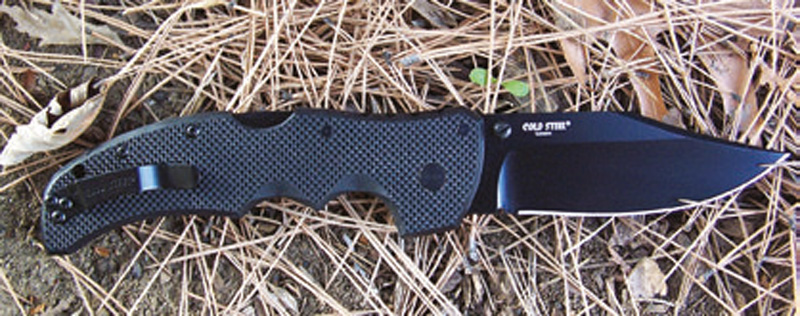 COLD STEEL RECON 1 CLIP POINT
COLD STEEL RECON 1 CLIP POINT
The Recon 1 series, with models in three- and four-inch blades, and even two-inch “Micro” versions, comes in clip point, drop point or tanto style, serrated or plain. It’s a strong design series, featuring their “Tri-Ad” lock and robust engineering. CS calls them tactical folders. We less romantic might call them real git ’er done tools. Tool abuse is either desperate or stupid, but these blades would take a lot. Their strong design, good materials, and precise manufacture have seen them well received by hard users.
The model overviewed here has a four-inch blade of AUS 8A stainless, 3.5mm thick, plain edged, with clip point and shallow hollow grind. It’s equipped with ambidextrous thumb stud and a clip that can be changed from left to right. Black “Tuff-Ex” PTFE coating enhances corrosion resistance and aids penetration. Overall length is 9 3/8 inches and 5 3/8 inches folded. It weighs 5.3 ounces. All models in this series have a relatively deep belly for a folder, which I favor in hard-work blades. Textured G-10 laminate scales feature double choils and coarse jimping at forward top for grip and control, plus a discrete lanyard hole.
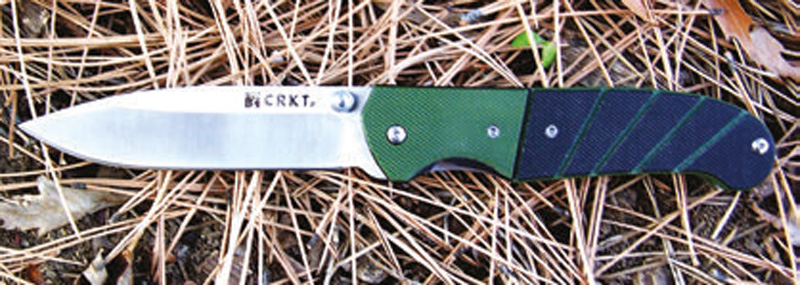 COLUMBIA RIVER KNIFE & TOOL IGNITOR
COLUMBIA RIVER KNIFE & TOOL IGNITOR
The CRKT Ignitor has some good and unique features for a valuepriced folder. The 3 3/8-inch blade is a modified drop point with high hollow-grind, made of Cr14MoV stainless hardened to 58-59RC. It is available with plain edge or partial Veff™ serrations, which are great on cordage. It’s 4¼ inches closed, 7½ inches open. The handle comprises layered G-10 scales, textured and CNC machined, with 2Cr13 stainless liners, one forming the lock. Its comfortable flat cross-section, deep choil, moderate parrot’s beak, and removable clip enhance deep-pocket or vest-pocket carry at 3.5 efficient ounces.
It features CRKT’s patented assisted opening, with their new Fire Safe™ mechanism, another point toward pocketability, or good for police work because a brave perp who might grab it won’t know how it works. The opening sequence is easily learned and fast, as the safety button is actually on the thumb stud. Available in different options, on the tactical Ignitor, the blade has a dark gray TiN coating.
 GERBER GATOR CLIP POINT
GERBER GATOR CLIP POINT
Gerber’s Gator Clip Point was a given for this roundup. Shortly after they came out, I had occasion to spend two long days digging and poking in sandy, rocky soil with one— up to the hilt and with twisting motions and imprudent prying. It took a couple hours to break in the slight grippiness of the rubberized overlay on the glass-filled nylon handle, but the blade never wavered or chipped under this abuse. I gave the blade a heavy touch-up on ceramic sticks and it was good to go: no point damage or scratches, just a polish on the matte finish.
Gerber says they have used 420HC from the git-go on this 3¾-inch lockback blade, and they got it right. The newer drop-point option uses 145CM, and both are available serrated, plus now in a fixed blade. Even with its comfortably rounded grip, it was an easy carry in a back pocket. It’s just shy of five inches closed, 8½ inches open, and weighs 5.4 ounces.
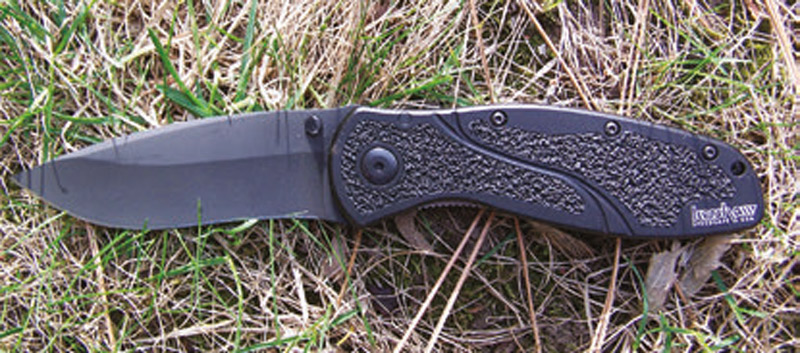 KERSHAW BLUR
KERSHAW BLUR
Ken Onion’s Blur design feels so right in your hand it’s hard to envision anything you’d change, but it’s available with many variations: plain, serrated, tanto point, composite blade, alloy options, handle colors. The Blur is just shy of eight inches open, 4½ inches closed, has a 3 3/8-inch blade that is 1/8-inch thick, slightly recurved and shallowly hollow ground of appropriate and varying high-grade stainless alloys. Ambidextrous ramped thumb studs ask only a nudge for “Speedsafe” fast opening. The drop point, DLC-coated blade rides effortlessly between phosphor bronze bushings, with a positive liner lock.
Lightweight 6160-T6 aluminum handles feature strongly textured and comfortably grippy Trac-Tec inserts. Handles mount on Kershaw’s hourglass spacers for a pillar construction with open architecture, handy for cleaning. Assembled with Torx screws, it can be fully dismounted when necessary. The clip mounts for tip-up or tip-down carry. Just under a half-inch thick and weighing four ounces, it feels so at home it’s hard to put down when the job at hand is finished. It’s made in the USA, with a variant probably just right for anybody.
 SCHRADE DROP-POINT FRAMELOCK
SCHRADE DROP-POINT FRAMELOCK
Schrade belongs to Taylor Brands, which contracts manufacture to their specs or imports selected models under their label, and they do it right. Not everybody does. During their 35 years specializing in stainless cutlery, I’ve seen them bring to market some good products, well worth the money. While making decent tools accessible, they’ve also introduced some innovative designs.
The Schrade 304 drop-point frame-lock knife is a current example. It’s a robust design—very robust compared to some of the lightweights— of solid stainless steel, with a tough matte-gray titanium coating overall. It has a 3¾-inch drop-point plain-edge 5/32-inch thick swedged blade of 9Cr18MoV high-carbon stainless with ambi thumb studs. A popular alloy in China, 9Cr18MoV is good if treated right. By our impromptu field tests, Taylor’s people do. It’s 4½ inches closed and 8½ inches overall, and weighs a solid 9.7 ounces. It has a lanyard hole, tip-down pocket clip, milled grooves for grip, open architecture, and smooth open/fold with one hand. Unusual. We like it.
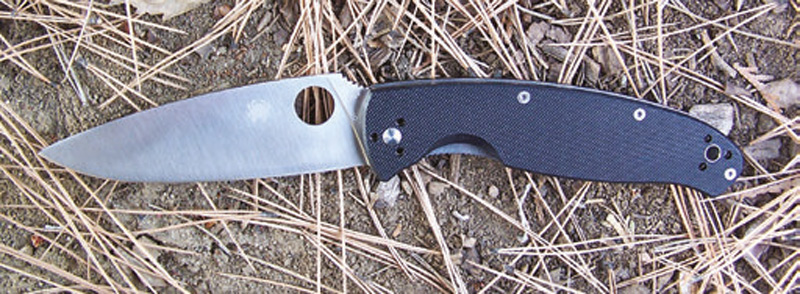 SPYDERCO RESILIENCE
SPYDERCO RESILIENCE
Since their first knives, Spyderco has always been a pioneer of EDC practicality: one-hand opening, serrated blades, locking blades, strength-to-weight ratio, and clip-mounting options. Users, and the industry, owe a lot to their innovations. Although they change hands among aficionados, you seldom see a used Spyderco just “for sale.” That says a lot.
This includes their line of value folders. The Resilience has the better Spyderco signature features such as a four-way clip (left or right, up or down), screw-together construction, a flat-ground 4¼-inch blade of 8Cr13MoV stainless smoothly pivoting between phosphor bronze bushings. It has a skeletonized stainless liner, G-10 handle scales, spine and liner jimping for blade control, Walker-style liner lock, inherently ambidextrous and enlarged opening hole for gloves, in a 5¼-inch folded, 9 3/8-inch overall envelope at an efficient 5.4 ounces.
The Resilience carries the quintessential Spyderco design features and function, at what they call a value price—although I think even their high-end blades represent very good value for the dollar.

